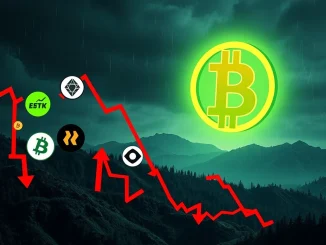
The world of cryptocurrency has always been synonymous with dramatic swings and cyclical patterns, but what if those days are behind us? In a groundbreaking declaration that’s sending ripples through the digital asset community, Bitwise Asset Management Chief Investment Officer Matt Hougan has stated that the traditional 4-year crypto cycle is officially over. This isn’t just a bold prediction; it’s a reflection of profound structural shifts driven by unprecedented institutional adoption and evolving crypto regulation. For anyone following Bitcoin News Today, this signals a pivotal moment, promising a more mature and stable market landscape.
Bitcoin News Today: The Dawn of a New Crypto Era?
For years, the cryptocurrency market has largely followed a predictable 4-year rhythm, often dictated by events like Bitcoin halvings. These supply-side shocks would trigger boom-and-bust cycles, captivating traders and investors alike. However, according to Matt Hougan, those days are fading into history. He posits that the market’s reliance on such cyclical patterns is diminishing, replaced by a more sophisticated and resilient framework. This new phase is characterized by sustained, stable growth, a stark contrast to the abrupt volatility that defined prior cycles. The implications for long-term investors and the broader financial ecosystem are immense, as the market matures beyond its speculative infancy.
Why the Traditional 4-Year Crypto Cycle is Evolving
What exactly is causing this monumental shift away from the established 4-year crypto cycle? Hougan points to a significant rebalancing of market forces. Historically, Bitcoin halvings were the primary catalysts, creating scarcity and driving price surges, followed by corrections. However, as the market capitalization of cryptocurrencies like Bitcoin and Ethereum has grown exponentially, the impact of these supply shocks is becoming less pronounced. The sheer volume of capital now flowing into the ecosystem means that individual events have a reduced capacity to trigger widespread, dramatic swings. Instead, a confluence of macro factors and strategic capital deployment is taking the wheel, leading to a more balanced trajectory and a departure from the sharp peaks and troughs of yesteryear.
The Unprecedented Rise of Institutional Adoption
Perhaps the most significant factor reshaping the market is the surging wave of institutional adoption. Major financial players, from hedge funds to asset managers and even sovereign wealth funds, are no longer on the sidelines. Their entry brings not only vast sums of capital but also a long-term investment philosophy that prioritizes stability and sustainable growth over short-term speculation. This influx of institutional capital is fundamentally altering market dynamics, particularly for flagship assets like Bitcoin and Ethereum. Their participation contributes to greater liquidity and reduced price sensitivity to supply shocks, underpinning a more resilient market. This strategic allocation by institutions is a key differentiator in this new era, paving the way for a more mature investor base.
Navigating the Landscape of Bitcoin ETFs and Crypto Regulation
The approval of Bitcoin ETFs in major markets has been a game-changer, acting as a powerful catalyst for transformative market changes. These regulated investment vehicles have democratized access to digital assets, making it easier and safer for both institutional and retail investors to gain exposure without directly holding cryptocurrencies. This normalization of access is crucial for fostering a more mature investor base.
Parallel to this, the evolving landscape of crypto regulation is providing much-needed clarity and infrastructure advancements. As governments and regulatory bodies around the world establish clearer guidelines, it builds confidence among traditional financial institutions, further enabling their alignment with the crypto space. This combination of accessible investment products like Bitcoin ETFs and robust regulatory frameworks is expected to mitigate the volatility historically tied to crypto cycles, creating a landscape where growth is sustained by capital deployment and regulatory progress rather than speculative fervor.
What Does This Mean for Your Crypto Investments?
Hougan’s insights underscore a critical inflection point. For investors, this shift implies:
- Reduced Extreme Volatility: While crypto will always have some level of price movement, the era of 80%+ corrections post-halving may be less frequent or severe.
- Focus on Fundamentals: Investment logic, rather than supply-side events, is expected to drive market behavior. This means a greater emphasis on project utility, technological advancements, and real-world adoption.
- Long-Term Value Creation: The market is poised for a period of stabilization, where strategic allocation and sustained growth become the norm. This encourages a long-term investment horizon.
- Increased Integration: Expect cryptocurrencies to become more deeply integrated into global finance, moving from a niche asset class to a recognized component of diversified portfolios.
This doesn’t mean the market will be entirely free of fluctuations, but the underlying drivers are shifting towards more traditional financial principles. It’s a call for investors to adapt their strategies, moving away from purely speculative trading towards a more analytical and patient approach.
Conclusion:
Matt Hougan’s declaration that the 4-year crypto cycle is over is more than just a headline; it’s a profound assessment of a maturing market. The interplay of surging institutional capital, regulatory clarity, and advanced infrastructure is fundamentally reshaping the trajectory of digital assets. As we move forward, the crypto landscape promises to be less about wild swings and more about sustainable, long-term value creation. This new era, driven by strategic investment and robust frameworks, marks an exciting and transformative chapter for Bitcoin, Ethereum, and the entire cryptocurrency ecosystem. Stay informed, stay strategic, and prepare for a future where digital assets play an increasingly integral role in global finance.
Frequently Asked Questions (FAQs)
- What is the traditional 4-year crypto cycle?
- The traditional 4-year crypto cycle refers to the historical pattern of Bitcoin’s price movements, often correlated with its halving events which occur approximately every four years, leading to periods of boom and bust.
- Why does Bitwise CIO Matt Hougan believe the cycle is over?
- Matt Hougan argues that the cycle is ending due to the diminishing influence of halvings and the growing dominance of institutional capital and regulatory developments, which are bringing greater stability and sustained growth to the market.
- How does institutional adoption impact the crypto market?
- Institutional adoption brings significant capital inflows, increased liquidity, and a long-term investment philosophy, which reduces market volatility and reliance on cyclical supply shocks, fostering a more stable and mature ecosystem.
- What role do Bitcoin ETFs and crypto regulation play in this shift?
- Bitcoin ETFs normalize access to digital assets for a broader investor base, while evolving crypto regulation provides clarity and builds confidence for traditional financial institutions, both contributing to market maturation and reduced speculative behavior.
- What does this mean for individual crypto investors?
- For individual investors, this shift suggests a move towards reduced extreme volatility, a greater emphasis on fundamental analysis, and an encouragement for long-term investment strategies focused on sustained value creation rather than short-term gains.



